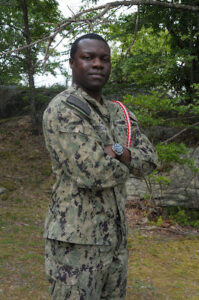A sailor from St. Thomas, U.S. Virgin Islands, is training students to continue a 123-year tradition of service under the sea.

James Green)
Submariners play a critical role in carrying out one of the Defense Department’s most important missions: strategic deterrence. As an instructor at Navy Submarine School, Petty Officer 2nd Class Causton Merchant Jr. is teaching sailors the skills needed to operate aboard submarines so they can successfully complete missions around the world.
“My family inspired me to join the Navy,” said Merchant. “I have a son and I joined to give better opportunities to him.”
Growing up in St. Thomas, Merchant attended Charlotte Amalie High School and graduated in 2007.
Skills and values similar to those found in St. Thomas are similar to those required to succeed in the military.
“Some lessons from my home that apply to my naval carer are resiliency and the ability to adapt,” said Merchant. “You are not going to succeed at all times, so you need to have the resiliency to push forward even when you fail. The ability to adapt is important in the Navy because people come from all different backgrounds so if you know how to adapt, you can lead them better.”
These lessons have helped Merchant while serving in the Navy.
Known as America’s “Apex Predators!” the Navy’s submarine force operates a large fleet of technically-advanced vessels. These submarines are capable of conducting rapid defensive and offensive operations around the world in furtherance of U.S. national security.
There are three basic types of submarines: fast-attack submarines (SSN), ballistic-missile submarines (SSBN) and guided-missile submarines (SSGN).
Fast-attack submarines are designed to hunt down and destroy enemy submarines and surface ships; strike targets ashore with cruise missiles; carry and deliver Navy SEALs; conduct intelligence, surveillance, and reconnaissance missions; and engage in mine warfare. The Virginia-class SSN is the most advanced submarine in the world today. It combines stealth and payload capability to meet Combatant Commanders’ demands in this era of strategic competition.
The Navy’s ballistic-missile submarines, often referred to as “boomers,” serve as a strategic deterrent by providing an undetectable platform for submarine-launched ballistic missiles. SSBNs are designed specifically for stealth, extended patrols and the precise delivery of missiles. The Columbia-class SSBN will be the largest, most capable and most advanced submarine produced by the U.S. – replacing the current Ohio-class ballistic-missile submarines to ensure continuous sea-based strategic deterrence into the 2080s.
Guided-missile submarines provide the Navy with unprecedented strike and special operation mission capabilities from a stealthy, clandestine platform. Each SSGN is capable of carrying 154 Tomahawk cruise missiles plus a complement of heavyweight torpedoes to be fired through four torpedo tubes.
“Our mission remains timeless – to provide our fellow citizens with nothing less than the very best Navy: fully combat ready at all times, focused on warfighting excellence, and committed to superior leadership at every single level,” said Adm. Mike Gilday, Chief of Naval Operations. “This is our calling. And I cannot imagine a calling more worthy.”
Serving in the Navy means Merchant is part of a team that is taking on new importance in America’s focus on strengthening alliances, modernizing capabilities, increasing capacities and maintaining military readiness in support of the National Defense Strategy.
“The Navy’s contribution to national security is simple,” said Merchant. “Our powerful fleet is a show of force and acts as a deterrent to adversaries. We have a reach around the world with our forward presence overseas and maritime security of borders and coastlines.”
With 90 percent of global commerce traveling by sea and access to the internet relying on the security of undersea fiber optic cables, Navy officials continue to emphasize that the prosperity of the United States is directly linked to trained sailors and a strong Navy.
Merchant and the sailors they serve with have many opportunities to achieve accomplishments during their military service.
“I am most proud of earning my submarine warfare device or ‘dolphins,’” said Merchant. “I am proud of that because I had to learn about the functions, capabilities and intricacies of all systems on board a nuclear-powered submarine. Earning those shows the trust my fellow sailors have in me if anything were to go wrong on the boat.”
As Merchant and other sailors continue to train and perform missions, they take pride in serving their country in the United States Navy.
“Serving in the Navy means that my family and friends get to enjoy the freedoms entitled to them as Americans,” said Merchant.
Merchant is grateful to others for helping make a Navy career possible.
“I want to thank Chief Topedoman Jarvis Walker for showing me how to be a leader,” added Merchant. “He taught me about what the submarine force is going to be. I also want to thank my cousin, Glencia Merchant, for being there for me when I need someone to talk to.”


